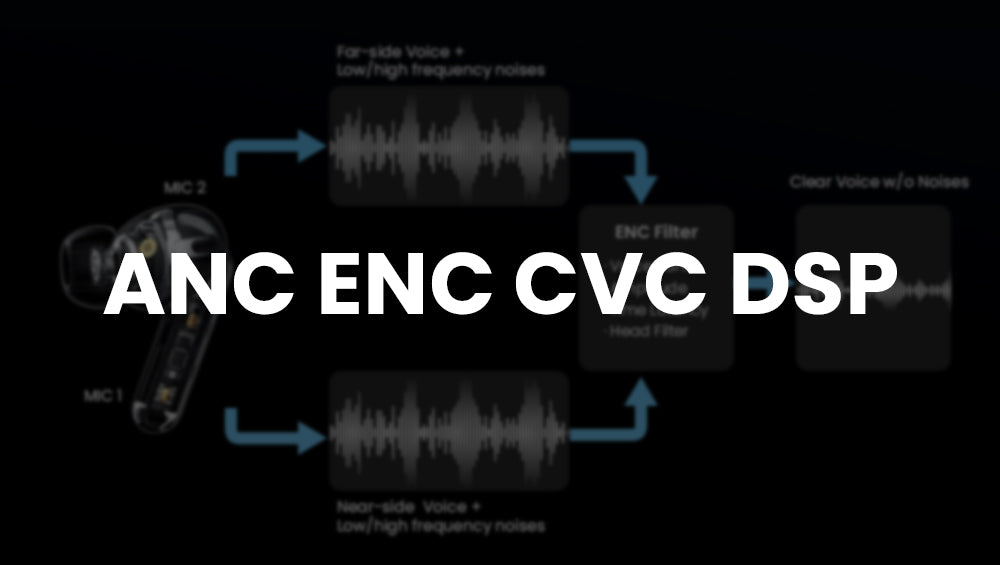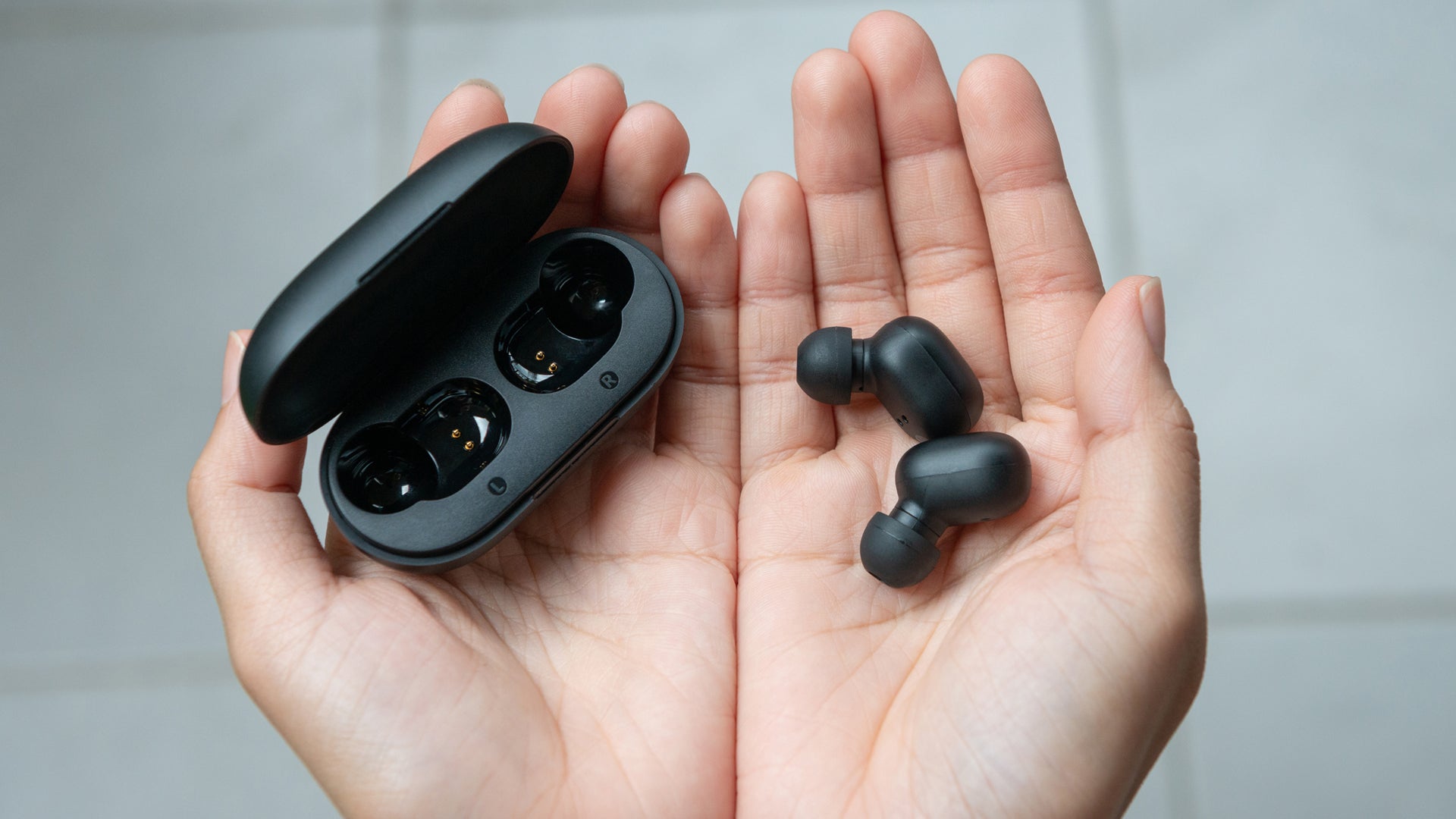Have you ever gone to buy a new pair of headphones or earplugs but got confused when you read its product specifications? What do the terms ANC, ENC, CVC, and SDP at the back of the gadget box mean? Do these product specifications help deliver more accurate sound? Also, how do these types of noise cancellation techniques actually make a difference in one’s listening experience?
If you don’t know the answers to these questions, then this article is for you!
This comprehensive guide will dig deeper into the world of ANC, ENC, CVC, and DSP noise reduction technology types, exploring each term individually to shed light on their inner workings. Safe to say, by the end of this article, you'll be fully equipped with all the knowledge needed to navigate the intricate landscape of sound technology.
So, the next time you are choosing your latest audio companion, whether be it a cutting-edge ANC headphone or the latest TRANYA CVC earbuds, you’ll make a better-informed decision that perfectly caters to your needs.
Now, without further ado, let’s begin!
Why Noise Reduction Technology Is Important?

Ambient noise has long been the arch-nemesis of audio enthusiasts and casual listeners alike.
Whether it's the incessant hum of background chatter in a crowded café, the rumble of engines during a long flight, or the intrusive sounds of a bustling city, external noise can mar our listening experiences and make it challenging to enjoy our favorite music in its true originality or focus on important audio lecture content.
This is where noise cancellation techniques come into the picture. Noise cancellation in sound gadgets is the process of reducing or eliminating unwanted ambient noise. It is an integral feature in modern-day headphones for improving the quality and clarity of sound, as well as protecting the hearing health of listeners.
By employing these various noise reduction technologies, many modern-day headphones and earplugs enhance the clarity and fidelity of sound reproduction, effectively creating and delivering an oasis of sonic bliss to a listener amidst a sea of distractions!
The 2 Main Types of Noise Cancellation Techniques

There are two main types of noise cancellation techniques: passive noise reduction and active noise reduction.
- Passive Noise Reduction
Passive Noise Reduction, also known as Sound Isolation or Noise Isolation, is a noise cancellation technique that aims to block out external sounds without the need for any power source. It involves using materials and design elements that create a physical barrier between the listener’s ears and the surrounding noise.
Consequently, these barriers help prevent sound waves from reaching the listener's ears, thereby reducing the overall noise level. Passive Noise Reduction work remarkably well against high frequencies.
- Active Noise Reduction
Active Noise Reduction, on the other hand, is a more advanced and sophisticated form of noise reduction technology. It works by creating a sound wave that is opposite in phase to the unwanted sound wave and adding it to the original sound signal. Consequently, this creates a destructive interference that cancels out the unwanted sound.
Active Noise Reduction relies on built-in microphones to capture the surrounding sound and specialized circuitry to produce anti-noise sound waves. This noise cancellation technique is highly effective against low frequencies like airplane engines or the hum of air conditioners.
Types of Active Noise Reduction Technology
Active Noise Cancellation (ANC)

Active Noise Cancellation (ANC) is a remarkable noise reduction technology type that has revolutionized the way we experience audio in noisy environments. ANC works by actively monitoring the ambient sound around us and generating sound waves that are precisely phase-inverted to cancel out the unwanted noise.
In essence, ANC-enabled devices contain microphones that capture external noise. This captured sound is then processed by dedicated ANC circuitry, which generates anti-noise signals. These anti-noise signals are played back through the device's speakers or drivers, effectively cancelling out the incoming noise.
The magic of Active Noise Cancellation lies in the principle of destructive interference. By creating sound waves that are out of phase with the incoming noise, ANC ensures that the two waves collide and cancel each other out. This results in a significant reduction in the perceived noise level, allowing the listener to enjoy their audio content in its true originality.
This noise cancellation technique is highly effective in reducing constant, low-frequency noises, such as engine rumble, airplane cabin noise, or the hum of air conditioning units. It excels in creating a sanctuary of silence, allowing listeners to fully immerse themselves in their music, podcasts, or movies, even in bustling and noisy surroundings.
One prominent example of ANC-enabled devices includes the Bose QuietComfort series of headphones. These headphones utilize advanced Active Noise Cancellation algorithms to analyze and counteract external noise, providing a peaceful and immersive listening experience.
Environment Noise Cancellation (ENC)

Environment Noise Cancellation (ENC) is another type of noise reduction technology that focuses on enhancing voice clarity during voice communication. While ANC primarily targets external noise in general, ENC specifically hones in on environmental noises that can interfere with clear voice transmission.
ENC usually works by using two microphones: one near the mouth and one on the outer part of the earphone or headphones. The inner microphone captures the voice of the user and amplifies it. The outer microphone captures the noise around the user and reduces it. Then, both optimized sounds are sent through, so the receiver hears only the clear voice of the user.
The Environment Noise Cancellation technique works best for reducing high-frequency noises, such as human voices, keyboard typing, or wind noise. ENC-equipped sound gadgets are commonly found in communication devices, such as headsets or earphones used for phone calls or video conferences.
By effectively cancelling out ambient noises like background chatter, traffic, or wind, ENC ensures that the user's voice is transmitted clearly and intelligibly to the receiving end.
Examples of ENC devices include gaming headsets, such as Avantree Alto 8060, Razer Kraken Ultimate, or HyperX Cloud II Wireless. These headsets use a boom mic with two microphones to cancel out the environmental noise and deliver crystal-clear voice communication to teammates or opponents.
Clear Voice Capture (CVC) 
Continuing with the flow, Clear Voice Capture (CVC) is a software-based approach to noise reduction technology. Introduced by Qualcomm, CVC is specifically designed to enhance voice quality during hands-free communication, particularly in noisy environments. It focuses on reducing background noise and optimizing the captured voice signal to deliver clear and intelligible audio during phone calls or voice commands.
CVC employs advanced algorithms and signal processing techniques to identify and suppress unwanted noise while preserving the integrity of the user's voice. This noise cancellation technique works by using a single microphone to capture the voice of the user and filter out the ambient noise.
One of the key features of Clear Voice Capture is its ability to adapt and adjust in real time. It continuously monitors the changing acoustic environment, dynamically adjusting the noise reduction parameters to provide optimal voice clarity.
As such, it enhances voice quality by applying automatic gain controls, equalizers, comfort noise, howling control, nonlinear processing, adaptive equalizers, power savings techniques, auxiliary stream mixing, and frequency-enhanced speech intelligibility.
Clear Voice Capture works best for reducing echoes and reverberations that can affect the clarity of voice calls. CVC is also more effective for situations where there is a lot of background noise, such as in a car, office, or street.
An example of a CVC device is an earphone, such as TRANYA T6. This earphone uses CVC technology to reduce ambient noise and enhance voice clarity during calls or voice recordings.
Digital Signal Processing (DSP)

Last but not least, DSP (Digital Signal Processing) is yet another noise reduction technology type. It uses mathematical operations to manipulate and enhance digital signals, such as audio, video, or images. It is used for various purposes, such as noise reduction, signal filtering, signal compression, signal enhancement, signal synthesis, and signal analysis.
DSP works by using a microphone to collect ambient sound and a processor to apply algorithms to the digital signal. The processor can perform different functions depending on the desired outcome. It can analyze, filter, and modify audio signals to optimize their quality, including reducing noise components.
For noise reduction, the processor can use techniques such as noise shaping, spectral subtraction, or adaptive filtering to reduce or remove unwanted noise from the signal. DSP can also use techniques such as equalization, compression, or reverb to enhance or modify the signal.
Although Digital Signal Processing can work for all frequencies of sound, it is more effective for high frequencies that are easier to process.
Examples of DSP-enabled devices include speakers, such as Bose SoundLink Revolve+, Sonos One, or JBL Flip 5. These speakers use DSP noise cancellation techniques to optimize the sound quality and performance according to the size, shape, and orientation of the speaker. They also use DSP technology to adjust the sound according to the environment and the user’s preferences.
Wrapping It All Up
As seen above, noise reduction technologies are essential for improving the quality and clarity of sound signals as well as protecting the hearing health of listeners.
There are different types of noise cancellation techniques, such as passive and active noise reduction, and within the active noise reduction category, there are ANC, ENC, CVC, and DSP. Each of these technologies has its own advantages and disadvantages, and the best choice often depends on a user’s needs and preferences.
What do you think? Share your thoughts with us and let us know in the comments below!



